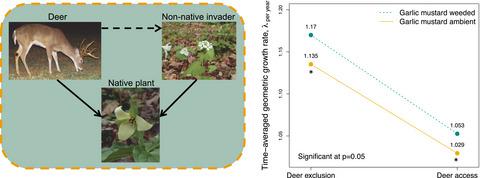Our official English website, www.x-mol.net, welcomes your feedback! (Note: you will need to create a separate account there.)
Direct effects of a non‐native invader erode native plant fitness in the forest understory
Journal of Ecology ( IF 5.5 ) Pub Date : 2019-07-19 , DOI: 10.1111/1365-2745.13233 Lalasia Bialic‐Murphy 1 , Nathan L. Brouwer 2 , Susan Kalisz 1
中文翻译:

非本地入侵者的直接影响侵蚀了林下植被的天然植物适应性
更新日期:2019-07-19
Journal of Ecology ( IF 5.5 ) Pub Date : 2019-07-19 , DOI: 10.1111/1365-2745.13233 Lalasia Bialic‐Murphy 1 , Nathan L. Brouwer 2 , Susan Kalisz 1
Affiliation

|
- The direct role of non‐native plant invaders in driving negative population‐ and community‐level processes of native species has been recently questioned. Addressing this controversy requires determining quantitatively if invaders negatively affect native population fitness. Because the invasion of non‐natives often coincides with other anthropogenic stressors, experiments that partition the putative impact of non‐natives from other known stressors and assess their potential synergies are required. While many studies have examined the effects of non‐natives on components of native plant performance, studies that decompose the net fitness effects of non‐natives from other anthropogenic stressors on population growth rate are lacking.
- We used 6 years of detailed demographic data to parameterize a size‐dependent integral projection model to examine the individual and combined effects of an allelochemical‐producing invader (Alliaria petiolata) and an overabundant ungulate herbivore (Odocoileus virginianus) on the population dynamics of an understory perennial (Trillium erectum).
- We show that Alliaria consistently and negatively affects the population dynamics of Trillium. Specifically, this invader reduces native population growth rate and alters the size distribution of the population at equilibrium. Alliaria also works in concert with the known negative impacts of overabundant white‐tailed deer, illustrating the additive effects of anthropogenic stressors on native plant dynamics.
- Synthesis. Alliaria's effects on vital rates differed in magnitude and sign across the native's life cycle, highlighting the importance of detailed demographic analyses. Our study provides novel empirical support for the claim that non‐native invasive species can significantly and directly reduce the fitness of native plants.
中文翻译:

非本地入侵者的直接影响侵蚀了林下植被的天然植物适应性
- 最近有人质疑非本地植物入侵者在推动本地物种的种群和社区一级消极过程中的直接作用。解决这一争议需要定量确定入侵者是否会对当地人口的适应性产生负面影响。由于非本地人的入侵通常与其他人为压力源同时发生,因此需要进行实验,以将非本地人的推定影响与其他已知压力源分开,并评估其潜在的协同作用。尽管许多研究已经检验了非本地人对本地植物性能成分的影响,但仍缺乏将非本地人与其他人为压力源对种群增长的净适应性分解的研究。
- 我们使用了6年的详细人口统计数据,对规模依赖的整体投影模型进行参数化,以检验产生化感物质的入侵者(Alliaria petiolata)和过多的有蹄类草食动物(Odocoileus virginianus)对地下种群动态的个体和综合影响多年生(延龄草)。
- 我们表明,大蒜对延龄草的种群动态有持续的负面影响。具体而言,这种入侵者降低了本地人口的增长率,并在平衡时改变了人口的规模分布。Alliaria还与过量的白尾鹿的已知负面影响协同工作,说明了人为胁迫因素对本地植物动态的累加作用。
- 综合。在当地人的整个生命周期中,Alliaria对生命率的影响在大小和体征上都不同,这突出了详细的人口统计分析的重要性。我们的研究为非本地入侵物种会显着直接降低本地植物的适应性这一说法提供了新的经验支持。



























 京公网安备 11010802027423号
京公网安备 11010802027423号